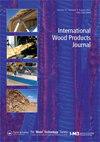In vitro biological control of Cedrus atlantica ‘s lignivorous fungi by the extracted essential oils from the infected wood
IF 0.9
Q2 MATERIALS SCIENCE, PAPER & WOOD
引用次数: 0
Abstract
ABSTRACTIn Morroco, Cedarwood lignivorous fungi cause significant damage to cedar groves. The losses have been estimated to be more than 30% due to these fungi. This latter brings about two primary diseases known as M'jej and Saboune. The study tries to show the molecular identification of the lignivorous fungi of the Atlas cedar in the cedar groves of Tazekka and Azrou and their biological control by the essential oils extracted from both the healthy and infected cedarwood. Therefore, this molecular research has identified three phytopathogenic fungi:(Paecilomyces maximus, Pleurostoma richardsiae, and Alternaria tenuissima). The data analysed in this study has also confirmed that the oil extracted from Saboune-infected wood showed a noticeable fungistatic effect against these fungi, with a MIC reaching 1/500, followed by the EO extracted from M'jej-infected wood. However, the healthy cedarwood gave an EO without antifungal activity. A mixture of these three oils gave significant antifungal results.KEYWORDS: BiocontrolCedrus atlantica Mcubic brown rot (Saboune)essential oilred ring rot (M’jej)Pleurostoma richardsiaePaecilomyces maximusAlternaria tenuissima AcknowledgementsThanks to the research team of biology (CNRST), Atika BENAYAD, Siham CHAUIYAKH, and Samir BENAICHA.Disclosure statementNo potential conflict of interest was reported by the authors.染病木材精油对大西洋雪松木质素食用菌的体外生物防治研究
摘要在摩洛哥,雪松木质素真菌对雪松林造成了严重的危害。据估计,这些真菌造成的损失超过30%。后者带来两种主要疾病,称为M'jej和Saboune。本研究对Tazekka和Azrou雪松林中的阿特拉斯雪松木质素真菌进行了分子鉴定,并对健康雪松和染病雪松精油进行了生物防治。因此,本分子研究鉴定出三种植物病原真菌:(Paecilomyces maximus, Pleurostoma richardsiae和Alternaria tenuissima)。本研究分析的数据还证实,从saboune感染木材中提取的油对这些真菌具有明显的抑菌作用,MIC达到1/500,其次是从M'jej感染木材中提取的EO。而健康杉木的EO无抗真菌活性。这三种油的混合物具有显著的抗真菌效果。关键词:生物防治大西洋杉木褐腐病(Saboune)香油环腐病(M’jej) richardpleurostoma maximaecilomyces alternuissima感谢生物学研究小组(CNRST) Atika BENAYAD, Siham CHAUIYAKH和Samir BENAICHA。披露声明作者未报告潜在的利益冲突。
本文章由计算机程序翻译,如有差异,请以英文原文为准。
求助全文
约1分钟内获得全文
求助全文
来源期刊

International Wood Products Journal
MATERIALS SCIENCE, PAPER & WOOD-
CiteScore
2.40
自引率
0.00%
发文量
27
 求助内容:
求助内容: 应助结果提醒方式:
应助结果提醒方式:


